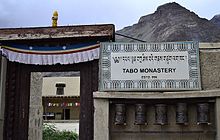Tabo Monastery
| Tabo Monastery | |
|---|---|

Tabo Gompa - old walls and chortens, 2004.
|
|
|
|
|
| Coordinates | 32°4′48″N 78°22′48″E / 32.08000°N 78.38000°ECoordinates: 32°4′48″N 78°22′48″E / 32.08000°N 78.38000°E |
| Monastery information | |
| Location | Spiti Valley, Himachal Pradesh, India |
| Founded by | Rinchen Zangpo |
| Completed | 996 |
| Date renovated | Early 1980s following 1975 Kinnaur earthquake |
| Type | Tibetan Buddhist |
| Sect | Gelug |
| Head Lama | Geshe Sonam Wangdui |
| Number of monks | 45 |
| Architecture | 9 temples, 4 Stupas, 23 chortens, monks quarters |
| [1] | |
Tabo Monastery (or Tabo Chos-Khor Monastery) is located in the Tabo village of Spiti Valley, Himachal Pradesh, northern India. It was founded in 996 CE in the Tibetan year of the Fire Ape. by the Tibetan Buddhist lotsawa (translator) Rinchen Zangpo (Mahauru Ramabhadra), on behalf of the king of western Himalayan Kingdom of Guge, Yeshe-Ö. Tabo is noted for being the oldest continuously operating Buddhist enclave in both India and the Himalayas. A large number of frescoes displayed on its walls depict tales from the Buddhist pantheon. There are many priceless collections of thankas (scroll paintings), manuscripts, well-preserved statues, frescos and extensive murals which cover almost every wall. The monastery is in need of refurbishing as the wooden structures are aging and the thanka scroll paintings are fading. After the earthquake of 1975, the monastery was rebuilt, and in 1983 a new Du-kang or Assembly Hall was constructed. It is here that the 14th Dalai Lama held the Kalachakra ceremonies in 1983 and 1996. The monastery is protected by the Archaeological Survey of India (ASI) as a national historic treasure of India.
The monastery is situated in the Spiti valley (an isolated valley with a total population of 10,000) above Tabo village on the left bank of the Spiti River. The valley as such is delimited by Ladakh in the north, Lahaul and Kullu districts in the west and south-east respectively, and by Tibet and the Kinnaur district in the east. While Tabo village is in a bowl-shaped flat valley, the monastery is also in the bottom of the valley, unlike other monasteries in the valley, which are perched on hills; in the past the region was part of Tibet.It is located in a very arid, cold and rocky area at an altitude of 3,050 metres (10,010 ft). Above the monastery there are a number of caves carved into the cliff face and used by monks for meditation. There is also an assembly hall in the caves and some faded paintings on the rock face.
...
Wikipedia

